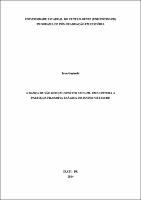| Compartilhamento |


|
Use este identificador para citar ou linkar para este item:
http://tede.unicentro.br:8080/jspui/handle/tede/249| Tipo do documento: | Dissertação |
| Título: | A DANÇA DE SÃO GONÇALO EM RIO AZUL-PR: UMA LEITURA A PARTIR DA FILOSOFIA TRÁGICA DO JOVEM NIETZSCHE |
| Título(s) alternativo(s): | não consta |
| Autor: | Gapinski, Ivan  |
| Primeiro orientador: | Antunes, Jair |
| Resumo: | O objetivo desta dissertação é apresentar um estudo acerca da dança de São Gonçalo no município de Rio Azul-PR, tendo como pano de fundo a concepção trágica da existência presente nos escritos de juventude do filósofo alemão Friedrich W. Nietzsche (1844-1900). Por meio da interpretação nietzschiana da Tragédia Grega e dos demais textos do primeiro período da produção desse autor, buscou-se compreender em que medida a dança criada pelo padre português Gonçalo de Amarante, no século XIII, - com o intento de converter prostitutas, e que chegou a ser dançada dentro das Igrejas quando chegou ao Brasil em meio à bagagem cultural do colonizador - pode ser concebida como indício de uma visão trágica de mundo. Essa devoção dançada sofreu perseguições e proibições tanto do estado português quanto da Igreja Católica, que percebia nela alguns excessos e resquícios de um paganismo que desejava extirpar da doutrina cristã. Todavia, a dança persistiu e é ainda encontrada em lugares onde a vigilância eclesiástica não logrou êxito, como nas comunidades do interior do Brasil. Ela pode ser encontrada também em algumas comunidades de Rio Azul-PR, como pagamento de promessa mediante graça recebida. Essa dança é acompanhada por violões, violas e cantorias, e mostra uma forma alegre de expressar a religiosidade e de conceber a vida. Conhecida entre os moradores da região como Romaria de São Gonçalo, é aqui entendida como um ritual trágico, visto que nela há a reconciliação, ainda que momentânea, de elementos aparentemente antagônicos, mas ao mesmo tempo complementares e necessários um ao outro, tais como vida e morte, sagrado e profano, assim como eram Apolo e Dioniso na tragédia grega, considerada por Nietzsche em sua juventude como a suprema arte afirmadora da existência. A metodologia utilizada foi a análise de depoimentos colhidos junto a moradores de algumas localidades de Rio Azul e de municípios adjacentes, que participam ou participaram das chamadas Romarias de São Gonçalo, contrapondo-as ao estudo histórico acerca do santo português e sua dança sagrada, à luz da interpretação nietzschiana da Tragédia Grega. |
| Abstract: | The purpose of this dissertation is to do a study on the São Gonçalo`s dance in the municipal district of Rio Azul PR, tends a backdrop the tragic conception of the present existence of the youth`s of the German philosopher writings of Fridrich W. Nietzsche (1844-1900). Through the nietzschean interpretation of Greek Tragedy and other texts of the first period of his production, it is looked for to understand in that measured the dance created by the Portuguese priest Gonçalo de Amarante in the thirteenth century - with the intent of converting prostitutes, and it was danced inside of the Churches when it arrived in Brazil amid the settler`s cultural luggage - it can be conceived as indication of a tragic vision of world. This danced devotion suffered persecutions and prohibitions so much of the Portuguese state as of the Catholic church, both saw in her some excess and traces of a paganism that wanted to extirpate of the Christian doctrine. Though, the dance persisted and it is found still in places where the ecclesiastical surveillance didn`t achieve success, as in the communities of the interior of Brazil. She also found in some communities of Rio Azul PR as payment promise by grace received. This dance is accompanied by guitars, violas and singings, and displays a cheerful form of expressing the religiosity and of conceiving the life. Known among the residents of the area as Pilgrimage of São Gonçalo is understood with a tragic ritual because in it there is the reconciliation although momentary among elements had as antagonistic, but at the same time complementally and necessary each other, such as life and death, sacred and profane, as well as they were Apollo and Dionisio in the Greek tragedy, considered by Nietzsche in his youth as the supreme art of the existence. The used methodology was the analysis of despoilments collected from residents of some places of Rio Azul and adjacent municipal districts that participate or they participated in the called Pilgrimages of São Gonçalo, in contrast to the historical study on the Portuguese saint and his sacred dance, to the light the nietzschean interpretation of Greek tragedy. |
| Palavras-chave: | Trágico Dança de São Gonçalo Rio Azul - PR Tragic Dance of the São Gonçalo Rio Azul - PR |
| Área(s) do CNPq: | CIENCIAS HUMANAS CIENCIAS HUMANAS::HISTORIA |
| Idioma: | por |
| País: | BR |
| Instituição: | UNICENTRO - Universidade Estadual do Centro Oeste |
| Sigla da instituição: | UNICENTRO |
| Departamento: | Unicentro::Departamento de História |
| Programa: | Programa de Pós-Graduação em História (Mestrado) |
| Citação: | GAPINSKI, Ivan. A DANÇA DE SÃO GONÇALO EM RIO AZUL-PR: UMA LEITURA A PARTIR DA FILOSOFIA TRÁGICA DO JOVEM NIETZSCHE. 2014. 135 f. Dissertação (Programa de Pós-Graduação em História - Mestrado) - Universidade Estadual do Centro Oeste, Irati, 2014. |
| Tipo de acesso: | Acesso Aberto |
| URI: | http://localhost:8080/tede/handle/tede/249 |
| Data de defesa: | 13-Dez-2014 |
| Aparece nas coleções: | Programa de Pós-Graduação em História |
Arquivos associados a este item:
| Arquivo | Descrição | Tamanho | Formato | |
|---|---|---|---|---|
| PR IVAN GAPINSKI.pdf | 1,52 MB | Adobe PDF |  Baixar/Abrir Pré-Visualizar |
Os itens no repositório estão protegidos por copyright, com todos os direitos reservados, salvo quando é indicado o contrário.




